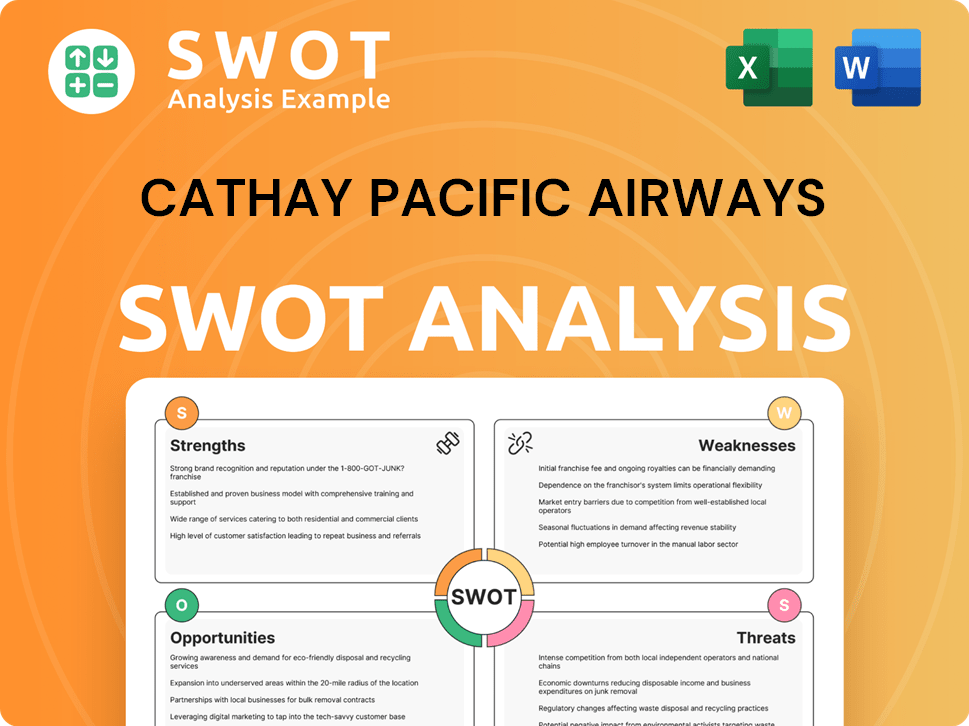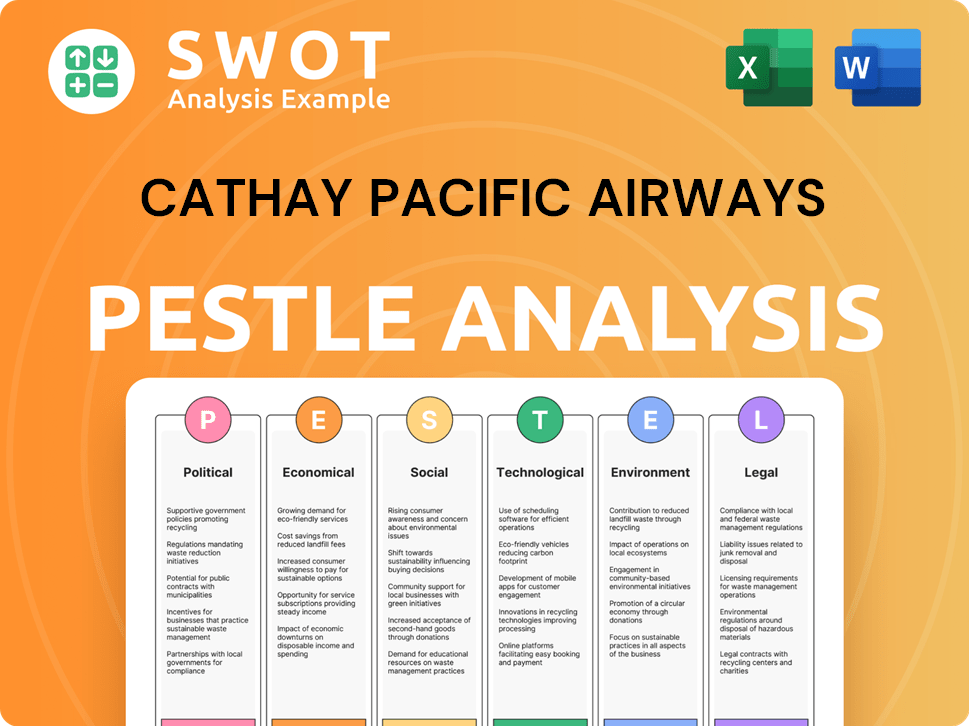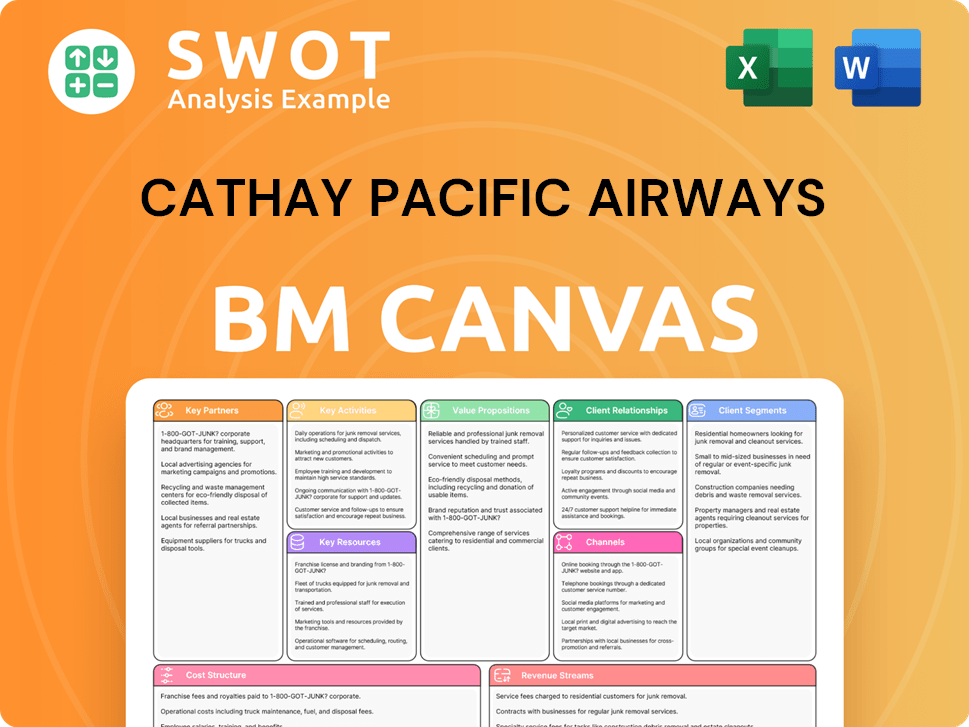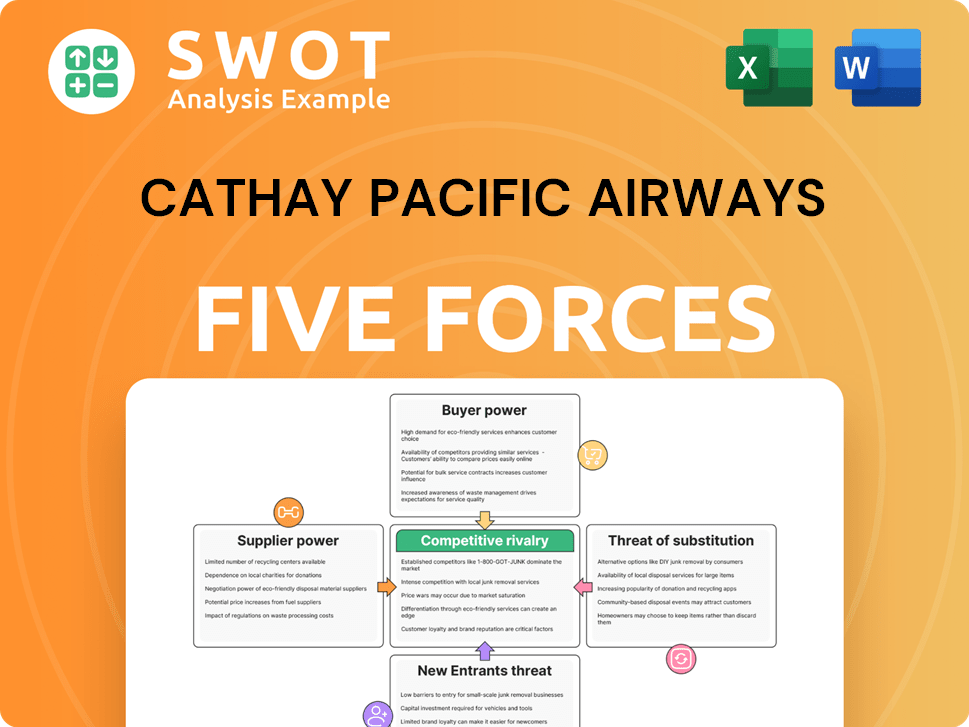Cathay Pacific Airways Bundle
How Does Cathay Pacific Airways Thrive in the Global Skies?
Cathay Pacific Airways, a leading Hong Kong airline, has demonstrated remarkable resilience, achieving a significant financial turnaround in 2024. This success underscores its crucial role in the global aviation landscape and its ability to navigate complex industry challenges. As a key player in connecting Hong Kong and mainland China with the world, understanding Cathay Pacific operations is vital.

Beyond passenger travel, Cathay Pacific's cargo services and strategic decisions are essential to its financial health and market position. To truly understand its operations, explore its Cathay Pacific Airways SWOT Analysis to gain insights into its strengths, weaknesses, opportunities, and threats within the competitive airline industry. This analysis will help you understand the airline business model, its route network, and its impact on Hong Kong's economy.
What Are the Key Operations Driving Cathay Pacific Airways’s Success?
Cathay Pacific Airways creates value primarily through its scheduled passenger and cargo services. It leverages its strategic hub in Hong Kong to connect destinations worldwide. The airline offers a range of passenger travel experiences, from premium to economy, and comprehensive air cargo solutions. Customer segments include leisure and business travelers, along with industries requiring global freight movement. The airline's operations are centered around providing extensive network connectivity and premium travel experiences.
Operational processes are extensive, involving flight planning, aircraft maintenance, ground handling, and a global sales and distribution network. Cathay Pacific has invested in modernizing its fleet, introducing new cabin products like the Aria Suite for business class and new Premium Economy cabins on its retrofitted Boeing 777-300ER aircraft in October 2024. Further enhancements are planned for 2025 and 2026, including a new first-class experience. Digital platforms are emphasized for an enhanced customer experience, including online booking and improved inflight entertainment with 4K screens and Wi-Fi connectivity across its fleet by August 2025.
The company's supply chain includes partnerships for aircraft acquisition, maintenance, and fuel. Its membership in the Oneworld alliance extends its global reach. Cathay Pacific differentiates itself through its strong brand reputation for service excellence, its strategic hub location in Hong Kong, and its significant presence in both passenger and air cargo sectors. This translates into an extensive network with over 190 destinations in 60 countries, premium travel, and reliable freight services, setting it apart in the competitive global aviation market. To understand more about the airline's strategic direction, consider reading about the Growth Strategy of Cathay Pacific Airways.
Cathay Pacific Airways offers passenger services, including premium and economy classes, and air cargo solutions. These services cater to leisure travelers, business travelers, and businesses needing global freight transportation. The airline continuously updates its offerings, with new cabin products and enhanced digital services.
The airline's operations involve flight planning, maintenance, and a global sales network. Investments in fleet modernization, such as retrofitted Boeing 777-300ER aircraft, and digital enhancements are key. By August 2025, the fleet will feature 4K screens and Wi-Fi.
Cathay Pacific collaborates with partners for aircraft, maintenance, and fuel. Membership in the Oneworld alliance extends its global reach. These partnerships enhance its ability to provide seamless travel experiences.
The airline offers extensive network connectivity, premium travel experiences, and reliable freight services. This differentiates Cathay Pacific in the competitive airline industry. The strategic hub in Hong Kong and strong service reputation are key differentiators.
Cathay Pacific operations are characterized by a focus on customer experience and operational efficiency. The airline's investments in new cabin products and digital enhancements reflect its commitment to providing a superior travel experience. The airline's strategic location in Hong Kong is a major advantage.
- Fleet modernization with new cabin products like Aria Suite and Premium Economy.
- Digital enhancements including online booking and improved inflight entertainment.
- Extensive network connectivity to over 190 destinations in 60 countries.
- Strong brand reputation and service excellence.
Cathay Pacific Airways SWOT Analysis
- Complete SWOT Breakdown
- Fully Customizable
- Editable in Excel & Word
- Professional Formatting
- Investor-Ready Format

How Does Cathay Pacific Airways Make Money?
The revenue streams and monetization strategies of Cathay Pacific Airways are multifaceted, primarily focusing on passenger and cargo services. In 2024, the company's total revenue reached HK$104,371 million (US$13.4 billion), reflecting a robust recovery and expansion across its core operations.
Passenger services and cargo operations are the main drivers of revenue. While passenger yields experienced some pressure due to increased market competition, cargo operations demonstrated resilience with improved yields. Additionally, Cathay Pacific employs various strategies to enhance customer loyalty and diversify revenue sources.
Cathay Pacific's financial performance overview highlights the importance of these strategies. The airline's ability to adapt to market dynamics and leverage its assets is key to its continued success in the competitive airline industry.
Passenger services are a major source of income for Cathay Pacific. In 2024, passenger revenue increased by 11.9% year-on-year, reaching HK$62.6 billion.
The airline, along with HK Express, carried over 28 million passengers in 2024, a 30.7% increase. However, passenger yields decreased, with Cathay Pacific's yields down 12% and HK Express's down 23% due to increased competition.
Cathay Cargo's revenue grew by 8.3% to HK$24,000 million (US$3.1 billion) in 2024. This growth was supported by strong demand, particularly from e-commerce shipments.
The airline transported 1.5 million tonnes of cargo, an 11% increase from 2023. Cargo yield improved by 2.9% to HK$2.82, indicating stable market pricing.
The Marco Polo Club has been revamped to enhance customer loyalty. The 'lifestyle business' expanded, enhancing offerings like Cathay Holidays and Cathay Shop.
Investments in associates contributed a profit of HK$288 million in 2024, a significant improvement from a loss of HK$1,562 million in 2023.
Cathay Pacific operations are significantly influenced by its ability to manage its fleet and route network. The airline's partnerships and alliances also play a crucial role in expanding its reach and offering. For more insights into the target market of Cathay Pacific Airways, you can read this article: Target Market of Cathay Pacific Airways.
Cathay Pacific employs several strategies to increase revenue and enhance customer loyalty beyond direct fares. These include:
- Revamped Marco Polo Club: Rewarding customers based on fare class, cabin, and distance flown.
- Lifestyle Business Expansion: Enhancing offerings such as Cathay Holidays and Cathay Shop.
- Strategic Investments: Benefiting from investments in associates.
- Cargo Services: Leveraging strong demand, especially from e-commerce.
Cathay Pacific Airways PESTLE Analysis
- Covers All 6 PESTLE Categories
- No Research Needed – Save Hours of Work
- Built by Experts, Trusted by Consultants
- Instant Download, Ready to Use
- 100% Editable, Fully Customizable

Which Strategic Decisions Have Shaped Cathay Pacific Airways’s Business Model?
Cathay Pacific Airways has demonstrated a strong recovery, achieving significant milestones in its recent history. The airline's financial performance in 2024 showed a robust rebound, marking its second consecutive year of profit with an attributable profit of HK$9.9 billion (US$1.27 billion). This turnaround is particularly notable after substantial losses since 2019 due to the COVID-19 pandemic, showcasing the airline's resilience and strategic adaptability. The Marketing Strategy of Cathay Pacific Airways has been instrumental in its resurgence.
A key strategic move for Cathay Pacific has been the completion of its two-year rebuilding journey. Flight capacity is set to return to 100% of pre-pandemic levels by January 2025. Furthermore, the airline plans to exceed 100 passenger destinations within the first half of 2025, with new routes including Rome, Dallas, and Urumqi. These expansions highlight Cathay Pacific's commitment to growth and its ability to capitalize on emerging market opportunities.
Operational challenges, such as industry-wide engine issues, have impacted the airline's profitability. For example, HK Express faced a HK$400 million loss in 2024 due to engine problems. Despite these hurdles, the company is actively enhancing its fleet modernization efforts and investing over HK$100 billion, including the acquisition of more than 100 new-generation aircraft. These investments are crucial for maintaining operational efficiency and competitiveness within the airline industry.
Cathay Pacific's competitive advantages include a strong brand reputation for service excellence, a strategic hub location in Hong Kong, and an extensive global network. The airline's dual-brand strategy, with Cathay Pacific as a premium full-service carrier and HK Express as a low-cost option, allows it to cater to diverse customer needs. Its strong cargo operations provide a diversified revenue stream.
The airline is focusing on digital transformation to improve customer experience, leveraging AI for operations and marketing, and prioritizing sustainability initiatives. The 2024 Sustainability Report highlights efforts to foster a local Sustainable Aviation Fuel (SAF) ecosystem and reduce single-use plastic items. These moves demonstrate a commitment to operational efficiency and environmental responsibility.
Cathay Pacific's financial performance in 2024 included an attributable profit of HK$9.9 billion (US$1.27 billion). The airline is expanding its route network, targeting over 100 destinations by the first half of 2025. Despite operational challenges, such as engine issues affecting HK Express, the company is investing heavily in fleet modernization and new technologies.
- Return to profitability after the pandemic.
- Expansion of the route network with new destinations.
- Significant investments in fleet modernization.
- Focus on digital transformation and sustainability.
Cathay Pacific Airways Business Model Canvas
- Complete 9-Block Business Model Canvas
- Effortlessly Communicate Your Business Strategy
- Investor-Ready BMC Format
- 100% Editable and Customizable
- Clear and Structured Layout

How Is Cathay Pacific Airways Positioning Itself for Continued Success?
Cathay Pacific Airways holds a significant position in the airline industry, particularly in the Asia-Pacific region. As a leading international airline, it benefits from its strategic hub in Hong Kong, serving as a vital link between the Chinese Mainland and the rest of the world. The airline's operations are influenced by its strong brand reputation, which is associated with high-quality service and customer loyalty.
The airline faces various risks, including global geopolitical uncertainties, trade conflicts, and supply chain challenges. Competition on regional routes also impacts passenger yields. Despite these challenges, Cathay Pacific is optimistic about future growth and is committed to substantial investments and strategic initiatives, including fleet modernization and enhanced digital innovations.
Cathay Pacific is a prominent player in the airline business model, especially within the Asia-Pacific region. It is among the top leaders in international seat capacity. Cathay Pacific's hub in Hong Kong is a critical connection point between China and the global market.
The airline faces geopolitical uncertainties and trade conflicts. Intense competition on regional routes leads to declines in passenger yields. Engine issues have affected the profitability of HK Express, impacting the overall financial performance overview.
Cathay Pacific aims to expand its network to over 100 passenger destinations by the first half of 2025. The airline is investing over HK$100 billion, coinciding with the launch of the Three-Runway System at Hong Kong International Airport. Fleet modernization and digital enhancements are key strategic initiatives.
In 2024, Cathay Pacific and HK Express carried over 28 million passengers. Cathay Pacific is committed to substantial investments of over HK$100 billion. The airline is focused on sustainable aviation fuel (SAF) and waste reduction.
Cathay Pacific is focused on expanding its network and improving customer experience. This includes fleet modernization with new-generation aircraft. Digital innovations are being implemented to enhance the customer experience and improve the booking process explained.
- Fleet modernization with new aircraft deliveries.
- Introducing new cabin interiors.
- Enhancing digital innovations.
- Focus on sustainability initiatives.
Cathay Pacific Airways Porter's Five Forces Analysis
- Covers All 5 Competitive Forces in Detail
- Structured for Consultants, Students, and Founders
- 100% Editable in Microsoft Word & Excel
- Instant Digital Download – Use Immediately
- Compatible with Mac & PC – Fully Unlocked

Related Blogs
- What are Mission Vision & Core Values of Cathay Pacific Airways Company?
- What is Competitive Landscape of Cathay Pacific Airways Company?
- What is Growth Strategy and Future Prospects of Cathay Pacific Airways Company?
- What is Sales and Marketing Strategy of Cathay Pacific Airways Company?
- What is Brief History of Cathay Pacific Airways Company?
- Who Owns Cathay Pacific Airways Company?
- What is Customer Demographics and Target Market of Cathay Pacific Airways Company?
Disclaimer
All information, articles, and product details provided on this website are for general informational and educational purposes only. We do not claim any ownership over, nor do we intend to infringe upon, any trademarks, copyrights, logos, brand names, or other intellectual property mentioned or depicted on this site. Such intellectual property remains the property of its respective owners, and any references here are made solely for identification or informational purposes, without implying any affiliation, endorsement, or partnership.
We make no representations or warranties, express or implied, regarding the accuracy, completeness, or suitability of any content or products presented. Nothing on this website should be construed as legal, tax, investment, financial, medical, or other professional advice. In addition, no part of this site—including articles or product references—constitutes a solicitation, recommendation, endorsement, advertisement, or offer to buy or sell any securities, franchises, or other financial instruments, particularly in jurisdictions where such activity would be unlawful.
All content is of a general nature and may not address the specific circumstances of any individual or entity. It is not a substitute for professional advice or services. Any actions you take based on the information provided here are strictly at your own risk. You accept full responsibility for any decisions or outcomes arising from your use of this website and agree to release us from any liability in connection with your use of, or reliance upon, the content or products found herein.